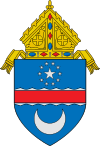History
In 1933, Beauvoir was established as a "separate and independent school in the Cathedral system" by the Cathedral Chapter. [5] The principal Elizabeth Glascock Taylor, and the faculty were motivated to "make children's education more exciting so that their students would be inspired to learn." [6]
Beauvoir was initially a segregated, all-white school, but accepted its first black student in 1952. [7]
In 2008, school employees discovered that a teacher, Eric Justin Toth, had created child pornography involving students. After five years on the FBI's Most Wanted List, he was apprehended after fleeing to Nicaragua and sentenced to 25 years in prison. [8]
In 2012, a new playground was completed. It was designed to appeal to children under 10 of varying ages and abilities, and featured in The Wall Street Journal . [9]
Curriculum
Beauvoir has always been focused on helping develop all aspects of the student. While K-3 curriculum still centers on the core elementary subjects, it also branches into social, emotional, and international subject areas. [12] [13]
All core subjects are taught by homeroom teachers except for foreign language (Spanish). [14] Subjects taught by homeroom teachers include reading and writing, [15] math, [16] and social studies. [17] Foreign language (Spanish), art, [18] music, [19] science, [20] and physical education [21] are each administered by at least one teacher who teaches across K-3.
All home rooms have at least two full-time teachers. This allows each homeroom teacher to specialize their areas of focus. Due to Beauvoir’s close teacher-student ratio, teachers are oftentimes able to work in small groups of 3-4 students to encourage critical-thinking and work towards a more 1-on-1 approach. Social and emotional learning is also taught in homerooms. These classes are meant to help students deal with social issues during and beyond their Beauvoir education. [22]
Kindergarten
The kindergarten grade is divided into two classes of roughly 15 students each. Kindergarten curriculum is focused on building foundational skills for learning the core subjects, [23] such as developing reading and basic addition and subtraction skills. Kindergarten students also learn basic Spanish and how to tell time on an analog clock.
First Grade
Beauvoir’s first grade curriculum is focused on expanding on the core-subject matter learned in Kindergarten. Students transition into slightly more advanced maths and learn how to follow the daily schedule and complete homework. One of the largest emphasis in first grade is one community engagement and participation in-class. First graders are all required to undergo WISC standardized testing mid-year. This is the first of two standardized tests offered at Beauvoir from K-3. [24]
Second Grade
Second grade’s strongest emphasis is on reading, as developing a broader vocabulary base as well as reading more elementary-level texts. Second graders continue to engage in community activities within Beauvoir and outside the school on various field-trips. Second graders also begin to develop their music education with various singing and tone-stick activities. [25]
Third Grade
At this point, the third grade is divided into 4 classes of 15 due to increases in enrollment as grades progress. Third grade is most notably designed to prepare students to continue their studies at St. Albans or The National Cathedral School. Both schools are noticeably more academically rigorous. Because of this, third graders develop more complex skills in arithmetic, reading and writing, and study more in-depth international social studies topics. In music, third graders are expected to perform a rendition of "Old MacDonald Had a Farm" on the recorder, [26] and spend a long time in music class learning to play the recorder. In science, students dissect small squid to discuss biology in a visual-oriented manner. Finally, one of the vital parts of Beauvoir's third grade curriculum is its preparation of students for their future studies. Third grade notably assigns increased homework from a multitude of subjects to reinforce the cumulative learning from the student's K-3 education. Third graders also take the second WISC test of their education at Beauvoir. [27]

A primary school, elementary school, or grade school is a school for primary education of children who are 4 to 10 years of age. Primary schooling follows preschool and precedes secondary schooling.
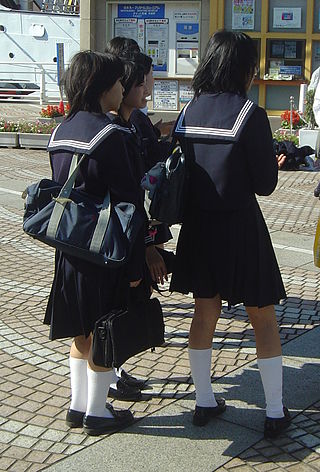
Secondary education in Japan is split into junior high schools, which cover the seventh through ninth grade, and senior high schools, which mostly cover grades ten through twelve.

Horace Mann School is an American private, independent college-preparatory school in the Bronx, founded in 1887. Horace Mann is a member of the Ivy Preparatory School League, educating students from the New York metropolitan area from nursery school to the twelfth grade. The Upper, Middle, and Lower Divisions are located in Riverdale, a neighborhood of the Bronx, while the Nursery School is located in Manhattan. The John Dorr Nature Laboratory, a 275 acres (111 ha) campus in Washington Depot, Connecticut, serves as the school's outdoor and community education center.

Saint Andrew's Episcopal School is an independent co-educational day school, which teaches pre-kindergarten to grade eight in Saratoga, Santa Clara County, California.
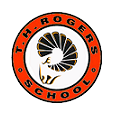
Thomas Horace Rogers School is an alternative primary and secondary public school and part of the Houston Independent School District. The school is at 5840 San Felipe in Houston, Texas, United States, outside of the 610 Loop and inside Beltway 8, west of Uptown Houston.
Educational stages are subdivisions of formal learning, typically covering early childhood education, primary education, secondary education and tertiary education. The United Nations Educational, Scientific and Cultural Organization (UNESCO) recognizes nine levels of education in its International Standard Classification of Education (ISCED) system. UNESCO's International Bureau of Education maintains a database of country-specific education systems and their stages. Some countries divide levels of study into grades or forms for school children in the same year.
The Westwood Regional School District is a comprehensive regional public school district serving students in kindergarten through twelfth grade from the communities of the Borough of Westwood and Washington Township in Bergen County, in the U.S. state of New Jersey, two communities located approximately 15 miles (24 km) northwest of Midtown Manhattan. The district is the county's only regional district serving grades K-12.

The Bergenfield Public School District is a comprehensive community public school district that serves students in pre-kindergarten through twelfth grade from Bergenfield in Bergen County, in the U.S. state of New Jersey.
Evergreen School District No. 114 is a public school district in Clark County, Washington, and serves the city of Vancouver. As of 2024, the district has an enrollment of about 22,000 students.

The Mahwah Township Public Schools is a comprehensive community public school district that serves students in pre-kindergarten through twelfth grade from Mahwah, in Bergen County, in the U.S. state of New Jersey.
The Lawrence Township Public Schools is a comprehensive community public school district that serves students in pre-kindergarten through twelfth grade from Lawrence Township, in Mercer County, in the U.S. state of New Jersey.
The North Arlington School District is a comprehensive community public school district that serves students in pre-kindergarten through twelfth grade from North Arlington in Bergen County, in the U.S. state of New Jersey.
Education in the Philippines is compulsory at the basic education level, composed of kindergarten, elementary school, junior high school, and senior high school. The educational system is managed by three government agencies by level of education: the Department of Education (DepEd) for basic education; the Commission on Higher Education (CHED) for higher education; and the Technical Education and Skills Development Authority (TESDA) for technical and vocational education. Public education is funded by the national government.
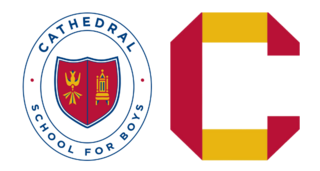
Cathedral School for Boys is a K-8 all-boys private Episcopal day school located next to Grace Cathedral on Nob Hill in San Francisco, California. Students are drawn from across San Francisco and the Bay Area.

Beijing City International School (BCIS) is an independent co-educational not-for-profit day school offering an international curriculum for toddler to twelfth grade students.
Saint Margaret School is a pre-Kindergarten through 8th-grade Elementary Catholic School in Pearl River, New York. It has been serving Rockland County's school districts since 1953. The school is known for its music program; students performed at the Lincoln Center in 2009.
The Common Core State Standards Initiative, also known as simply Common Core, was an American, multi-state educational initiative begun in 2010 with the goal of increasing consistency across state standards, or what K–12 students throughout the United States should know in English language arts and mathematics at the conclusion of each school grade. The initiative was sponsored by the National Governors Association and the Council of Chief State School Officers.

In the United States, elementary schools are the main point of delivery of primary education, for children between the ages of 4–11 and coming between pre-kindergarten and secondary education.
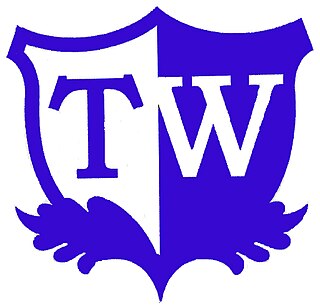
Tokyo West International School is an international kindergarten, elementary and middle school in Hachioji, Japan.


